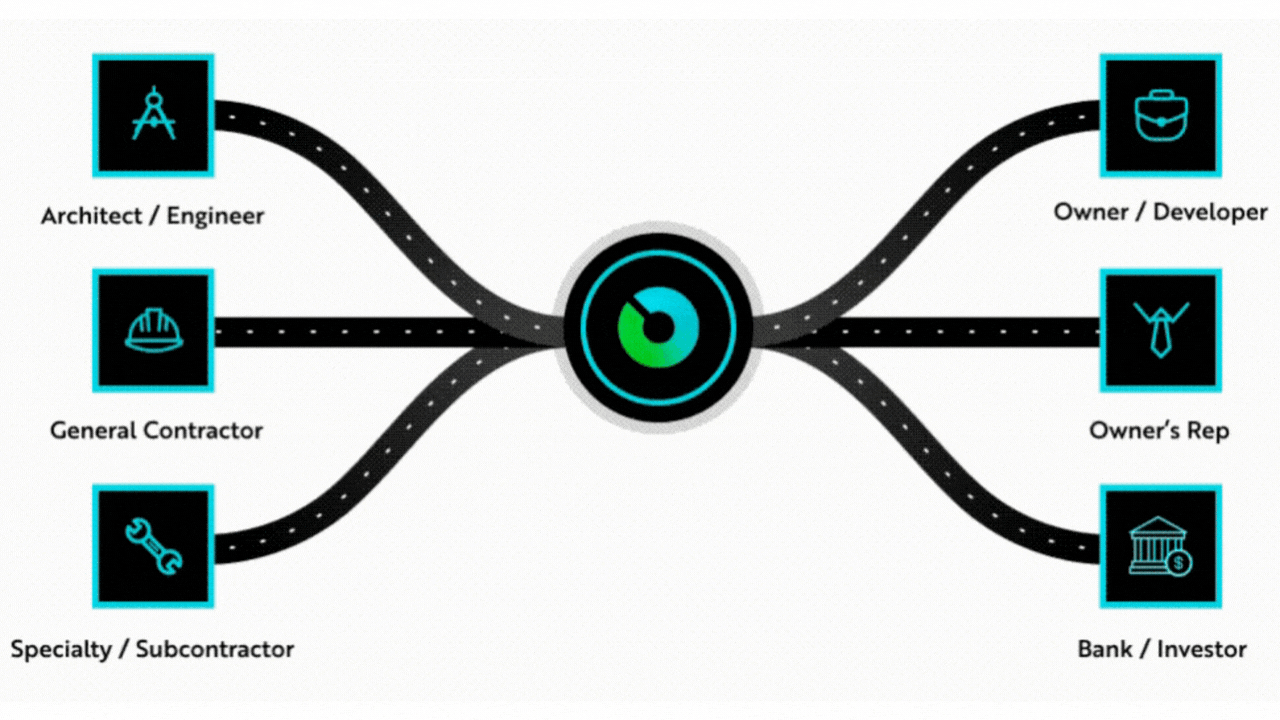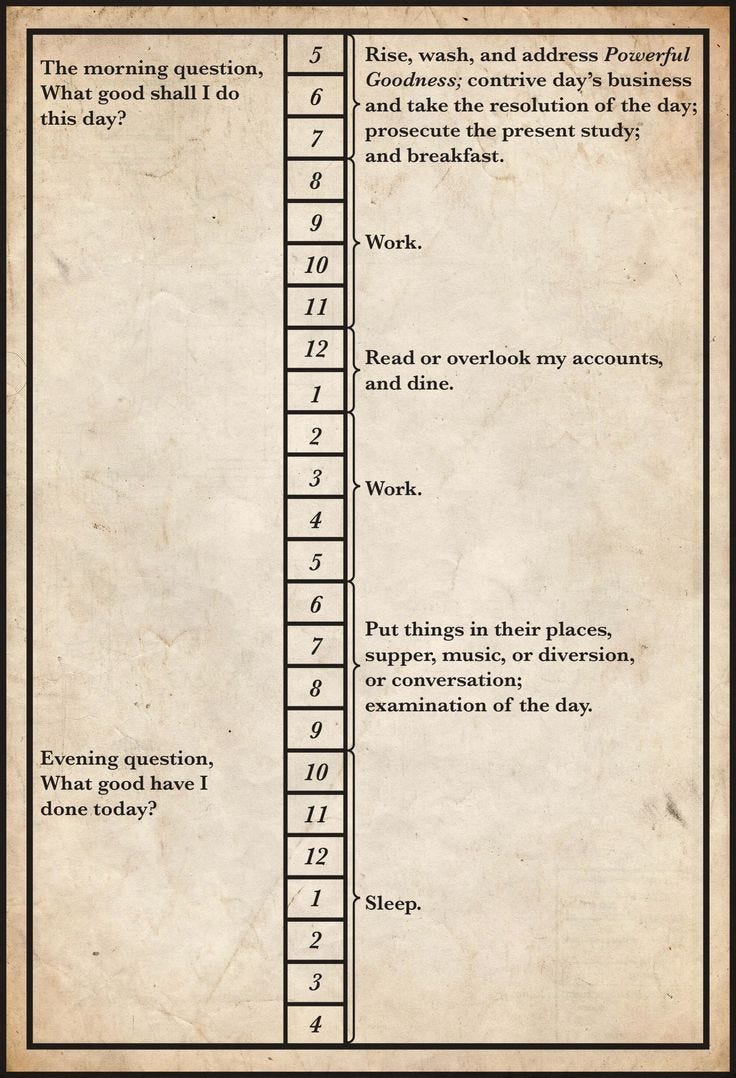👋 Hey, Kyle here! Welcome to The Influential Project Manager, a weekly newsletter covering the essentials of successful project leadership.
Today’s Overview:
Studying the daily routines of people you admire is a worthy pursuit. You can learn a lot about a person's priorities by breaking down their typical day. You may also learn something that will dramatically improve your own systems, habits, and processes.
Benjamin Franklin was one of the most prolific entrepreneurs, thinkers, and leaders in history. His routine wasn’t long or complex—it was structured around two core questions and six time blocks.
Mastering time requires balance. Learn Time-Blocking and the Four Types of Professional Time—(1) Management, (2) Creation, (3) Consumption, and (4) Ideation—to optimize your workday.
📊 Today’s issue is brought to you by INGENIOUS.BUILD!
Experience the future operating system for all Development & Construction projects.
Managing construction projects is tough. Using multiple tools that don't integrate pulls you away from your main goal—delivering great projects. The good news? I finally found a solution that works—today's sponsor—INGENIOUS.BUILD. It combines project management and financial workflows in one easy-to-use platform.
Here’s what I love:
Billing & Invoicing: Automate your billing, create professional invoices, and speed up payment cycles.
Cash Flow Forecasting: Link your budget and billings to stay on top of your project’s financial health.
Change Orders: Manage everything digitally with real-time updates, so you're never in the dark.
Want to see how it works for you? Join me and dozens of top companies at INGENIOUS.BUILD and upgrade your project operating system today.
🕒 The 4 Types of Professional Time
Filed under: Productivity
Want to know one of the best ways to improve your future? Study the past.
Benjamin Franklin—one of history’s most prolific entrepreneurs, thinkers, and leaders—designed his days with precision.
In his autobiography, he shared a breakdown of his daily calendar and routine.
Franklin’s routine, reproduced below, uses time-blocking, a simple time-management and calendar strategy that blocks out discrete windows of time for specific activities.
His entire day is batched into six blocks of time:
5:00 - 8:00 AM → Plan the day, reflect, study, and eat breakfast.
8:00 AM - 12:00 PM → Work.
12:00 - 2:00 PM → Read, review finances, and eat lunch.
2:00 - 6:00 PM → Work.
6:00 - 10:00 PM → Organize, unwind, converse, and reflect.
10:00 PM - 5:00 AM → Sleep.
While Franklin’s routine was clearly missing some of the life realities that many of us face today (childcare, home responsibilities, email, Zoom calls, and so on), its structured approach to time is something we can learn from.
How do high performers structure their time today? How do we balance focus, leadership, and daily responsibilities?
In today’s piece, I’m breaking down the 4 types of professional time (source: Sahil Bloom) and how to manage them for maximum impact.
What is Time-Blocking?
The concept of time-blocking is simple: Windows of time are blocked to work on distinct, specific tasks.
Instead of reacting to a never-ending to-do list, you control your day through your calendar.
Time-blocking leverages a well established psychological principle that setting an intention for your time is critical for driving progress. Planning your day in this manner will allow you to focus deeply on the specific tasks at hand, limit the negative impact of distractions, and give you a degree of control over what you do and when you do it.
I personally use time-blocking for my professional time—but I keep my personal time open and flexible.
For work, I follow a four-part framework that splits professional time across four areas.
The Four Types of Professional Time
To work smarter, not harder, you need a balanced mix of the four types of professional time:
Management
Creation
Consumption
Ideation
Most professionals overload their schedules with one or two types and neglect the rest—leading to inefficiency, burnout, and missed opportunities.
Let’s walk through each type to understand it more clearly.
Type 1: Management
The default mode of most professionals.
Management Time is essential—it ensures alignment, execution, and organization. But without guardrails, it consumes entire workdays, leaving little room for meaningful progress.
Typical activities include:
Meetings → Client, team, and stakeholder updates
Emails → Reviewing RFIs, contracts, and reports.
Team Management → Aligning people and processes.
Scheduling & Budgeting → Ensuring projects stay on track.
It can be highly productive and efficient, but it can also create the illusion of progress without actual results. Without balance, project managers get stuck in reactive mode—always responding, never leading.
Type 2: Creation
Creation Time is the second most common type of professional time. It’s what most of us scramble to get done in the gaps between Management Time blocks.
This is time spent producing real work that moves your projects forward.
Typical activities include:
Writing – Strategies, playbooks, and operational plans.
Developing – New workflows, processes, and improvements.
Building – Systems, automation, and better ways of working.
Preparing – Setting the stage for the future.
Thriving companies and careers are built in Creation Time. If you’re always managing and never creating, your work remains stagnant.
Type 3: Consumption
Consumption Time is where ideas are planted.
Every high-performer is an aggressive learner—because what you create is downstream from what you consume.
Typical activities include:
Reading industry reports, case studies, or leadership books.
Listening to podcasts or attending training sessions.
Studying best practices from other successful projects.
If you’re not intentionally consuming quality information, you’re making decisions with outdated knowledge.
Type 4: Ideation
Ideation Time is the most neglected type of professional time—but it’s where breakthroughs happen.
Most professionals never schedule time to think. They move from task to task, never stepping back to strategize, explore, or challenge assumptions.
Typical activities include:
Whiteboarding – Mapping out problems and solutions.
Brainstorming – Innovating workflows, strategies, and ideas.
Journaling – Documenting key lessons, reflections, and insights.
Walking & Thinking – Taking time to reflect and reassess.
Most of us have zero time for stillness and thought in our day-to-day professional lives, so we make linear progress and miss out on the asymmetric opportunities that require creative, nonlinear thinking.
How to Apply This to Your Schedule
Before you can make improvements to how you spend your time, you need to understand where it’s going.
I began with a simple calendar exercise to identify my own current balance across the four types of time.
Step 1: Audit Your Calendar
At the end of each workday for a week, color-code your calendar events using this key:
🟥 Management – Meetings, emails, coordination
🟩 Creation – Writing, planning, strategy
🟦 Consumption – Reading, learning, researching
🟨 Ideation – Thinking, brainstorming, reflecting
Step 2: Look for Patterns
❌ What color dominates your calendar?
❌ Is Creation Time squeezed between meetings?
❌ Is Ideation completely missing?
❌ Are your time blocks structured or scattered?
This simple exercise will expose gaps, inefficiencies, and imbalances in how you spend your professional time.
Step 3: Rebalance for Maximum Impact
Here are three tips for an optimal balance:
Tip 1: Batch Management Time
Management tasks expand to fill available space. Control them—or they’ll control you.
Batch meetings & calls into set windows (ex: AM & PM).
Limit email checking to 2-3 dedicated slots per day.
Block entire days for deep work if possible.
Leverage Parkinson’s law: Work expands to fit the time allowed for it. Compress your Management Time, and you’ll free up more space for high-value work.
Note: Your ability to do this will rise with your career progress. If you’re just starting out, then tiny, incremental batching improvements will be a win. If you’re further along in your career, you may be able to make more aggressive batching improvements.
Tip 2: Increase Creation Time
Creation is what propels us forward with more interesting projects and opportunities. We all need more Creation Time in our days.
Block it on your calendar (and treat it like an unmissable meeting).
Go all in—no emails, no notifications, no distractions.
Prioritize deep work over shallow busywork.
Thriving project professionals don’t find time for Creation—they make time for it.
Tip 3: Create Space for Consumption & Ideation
Consumption and Ideation are the forgotten types of time because we rarely create space for them, but they are critical to long-term, compounding progress.
History’s most successful people have all made a practice of creating space for reading, listening, learning, and thinking. We can draw a lesson from this.
Book one block per week for Consumption (reading, studying, researching).
Book one block per week for Ideation (thinking, strategizing, problem-solving).
Protect these blocks as fiercely as you would a critical meeting.
Every great leader makes time to think. This is where the biggest wins come from.
The Bottom Line
The three core principles to apply from the study of Benjamin Franklin's routine:
Don’t let Management Time dominate your schedule.
Prioritize Creation—it’s where real progress happens.
Make room for Consumption & Ideation—your future depends on it.
With these three tips in mind, you’re well on your way to finding a more optimal balance across the four types of professional time.
Give them a shot and experience the benefits immediately.
Until next week,
Kyle Nitchen

Whenever you're ready, there are 5 ways I can help you:
Get my first book! No Bullsh*t Project: A Project Manager’s Guide to Successful Project Leadership
Upgrade your scheduling software. Experience the future planning system for construction and real estate development. iPM subscribers get a 15% discount on the first year license.
Get my full toolbox (free). Access 30+ software and hardware tools I'm using today.
Learn Takt Planning. Elevate your skills as a scheduler, planner, and lean builder with the Takt Planning & Control online course. Use code "Influentialpmtakt" for 30% off.
Advertise in my newsletter. Put your brand in front of 6,300+ construction project managers, leaders, and execs. (Booked out 8 weeks)







